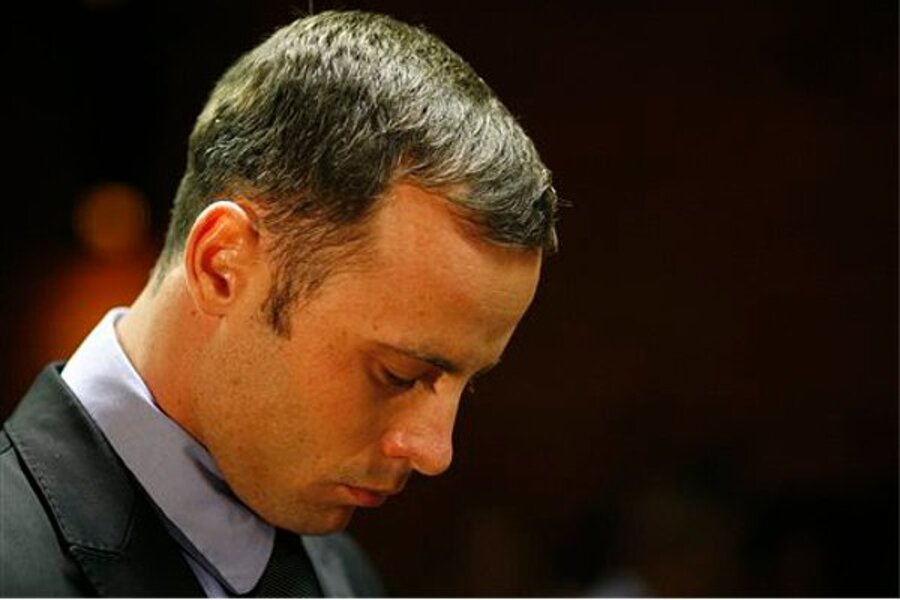49 cellphones confiscated for shooting Oscar Pistorius pictures
Loading...
| STELLENBOSCH, South Africa
Even police officers clamored to get photos of Oscar Pistorius on their cellphones after the famed Olympic athlete was arrested for the shooting death of girlfriend Reeva Steenkamp, South Africa's minister of police said in a written response to a question in parliament.
Police minister Nathi Mthethwa said 49 cellphones were confiscated from officers at Boschkop police station in Pretoria after they were used to take photographs of Pistorius when he was being transferred between court and the station soon after his arrest. Mthethwa made the revelation in a reply to parliament on Monday and it was seen by The AP on Tuesday.
"This action was necessary after it came to light that photos were taken of a high profile individual who had been arrested," Mthethwa wrote in the reply to a question by South Africa's opposition party, the Democratic Alliance.
The minister said four "official" cellphones and 45 private phones were taken from the officers on Feb. 20, six days after Pistorius' arrest. They could be used as evidence in possible disciplinary proceedings against the police officers, Mthethwa said. Mthethwa did not reveal how many officers had taken photos of Pistorius or how many — if any — are facing disciplinary action.
The former lead police investigator in the case also told The Associated Press that he had fears that reporters were trying to buy pictures of key pieces of evidence from officers in the first few days after the shooting, including the toilet door through which Pistorius fired the shots that killed Steenkamp inside the athlete's home in the predawn hours of Valentine's Day.
The door was then taken from inside the bathroom in Pistorius' house and put in "a body bag" and moved to a senior policeman's office, former detective Hilton Botha said.
Pistorius was initially held at Boschkop, a station close to his home in suburban Pretoria, after being arrested on Feb. 14 following the killing of Steenkamp at his house. The Olympian was later moved to another police station for his bail hearing at Pretoria Magistrate's Court.
South Africa's ministry of police declined to give further details on the cellphone photos and any possible disciplinary action against police officers, but the sensational Pistorius case has already cast doubts on the professionalism of South Africa's force.
The same former lead investigating officer, Botha, gave shaky evidence in court during Pistorius' bail hearing and it later emerged that Botha himself was facing seven charges of attempted murder. Botha was removed from the case and later resigned from the South African police.
Botha told the AP on Tuesday that when he was working the case, he had arranged for the toilet door to be taken from Pistorius' house and moved to Boschkop station after another officer told him she had been offered money to provide photographs of it to the media. The officer named by Botha couldn't immediately be reached for comment.
Botha did not name the media company or say how much money was offered, but said he was told that the offer was from an international media house and was "in dollars." Botha said he had learned that South African reporters were also trying to buy photographs of evidence and the crime scene from police.
South Africa's Star newspaper quoted Botha as telling it there was an offer of $50,000 for a photograph of the toilet door.
Two days after the shooting, the door was "sealed in a body bag" and moved to the office at Boschkop police station, Botha told The AP. It was later taken to a police evidence center by the investigating officer who replaced Botha, the former detective said.
No police officers have been implicated in any selling of pictures to reporters.
Despite the intense public interest in Pistorius, only one image of the double-amputee runner has emerged since he was freed on bail on Feb. 22. The photograph, also a cellphone photo but taken by a high school student, shows Pistorius wearing running gear and walking on his famous carbon fiber running blades when he visited his practice track at the University of Pretoria last month.
Pistorius won an appeal against some of his strict bail restrictions and has been more active recently while awaiting trial for Steenkamp's killing. His family said last week that he had been spending time with people close to his late girlfriend.
Pistorius was charged with murder in Steenkamp's shooting. He denies murder and says he shot her accidentally through a door inside his bathroom after mistaking her for a nighttime intruder. His next court appearance is June 4.







